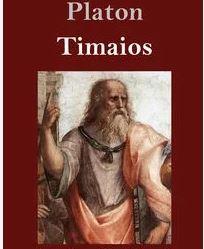Timaios

🧠 What is the Timaeus?
A Platonic dialogue in which Socrates, Critias, Hermocrates, and above all, Timaeus himself discuss the origin and structure of the universe. It is one of the few texts in ancient philosophy that feels almost scientifically esoteric.
✨ Central tenets of the Timaeus:
🔷 1. The universe as a whole is alive
Plato imagines the universe as a living being – animated and ordered. It was created by a divine demiurge (a creator god, but not omnipotent or personal), not out of nothing, but by ordering a chaotic primordial state according to a divine "archetype" (world of ideas).
👉 The demiurge is not a creator in the Judeo-Christian sense, but rather an orderly of the cosmos according to what is good and beautiful.
🔷 2. The soul is immortal
The world soul was created before the body and permeates the entire universe. Human souls also descend from this world soul – they are eternal, pre-existent, and survive death.
The soul "falls" into a body and can ascend again after death – depending on how pure or wise it has become.
🔷 3. Numbers, Harmony, and Geometry
The world is ordered by numerical relationships, music, and geometry – this is strongly reminiscent of esoteric and Pythagorean ideas. The entire cosmos has a harmonious structure, which is also reflected in the human soul.
🪐 The afterlife in the Timaeus
Plato does not explicitly speak of heaven and hell, but:
The soul is on a journey through various forms of existence.
A virtuous life leads to a return to the stars (to the divine realm).
An impure soul is reincarnated into lower life forms – a kind of esoteric transmigration of souls.
This is reminiscent of reincarnation, karma, and the idea of a spiritual maturation process – very close to many esoteric worldviews.
✨ Spiritual Essence of the Timaeus
🌟 1. The world is animated
The cosmos is not a dead mechanism, but a living, divine being – with its own world soul that permeates everything. In modern language, you might say:
"The universe is a conscious being – and we are part of it."
This view is absolutely central to many spiritual movements – whether in Hermeticism, modern esotericism, or mystical natural philosophy.
🧬 2. Humans are a microcosm
Plato (on the Timaeus) describes humans as an image of the cosmos – both physically and spiritually. Our soul is made of the same "material" as the world soul, only more individual.
"As above, so below" – this Hermetic principle is already contained in the Timaeus: Man is a mirror of the divine.
🔁 3. Transmigration and Purification
The soul is eternal and goes through various stages. After death, it is reborn – in a better or lower state – depending on its spiritual development.
The goal is:
Return to the origin,
Union with the divine,
or a state of pure contemplation (contemplation of the true and the good).
This is very similar to spiritual paths such as:
Reincarnation (Hinduism, Theosophy),
Soul development (Anthroposophy),
Mystical purification (Gnosis, Sufism).
🌀 4. Spiritual order behind everything
The Demiurge orders chaos according to the principle of harmony, truth, and beauty. This is strongly reminiscent of the idea that there is a divine intelligence or order behind everything – as in New Age, spiritual geometry, or the doctrine of the "divine plan."
The cosmos is not random. It is the expression of a loving, intelligent act of creation.
🧘 Spiritual relevance today
The Timaeus inspires many who today seek a spiritual worldview that:
is scientifically open but not materialistic,
sees consciousness as the origin (rather than matter),
and advocates the idea that we are connected to everything – cosmically and spiritually.

